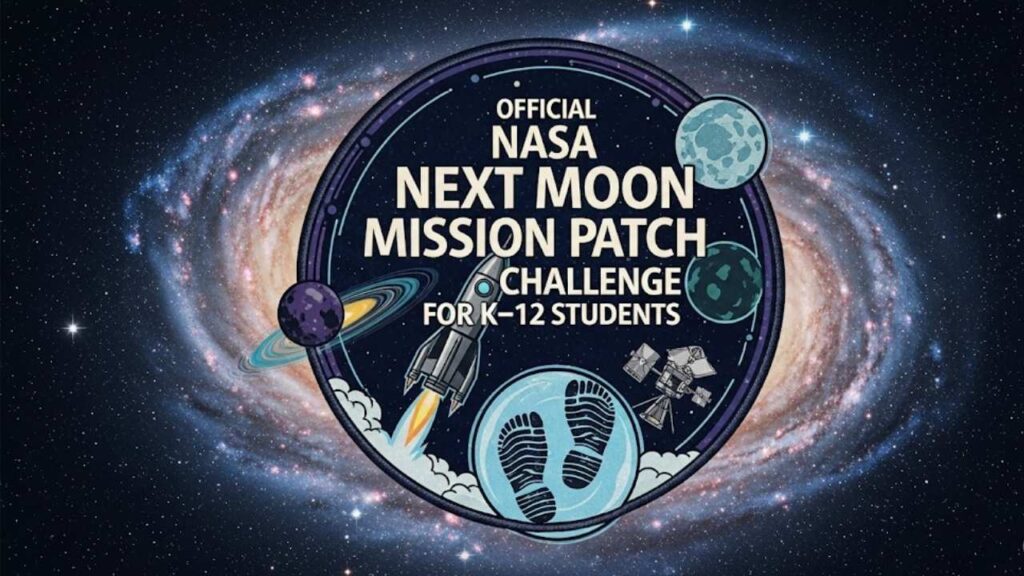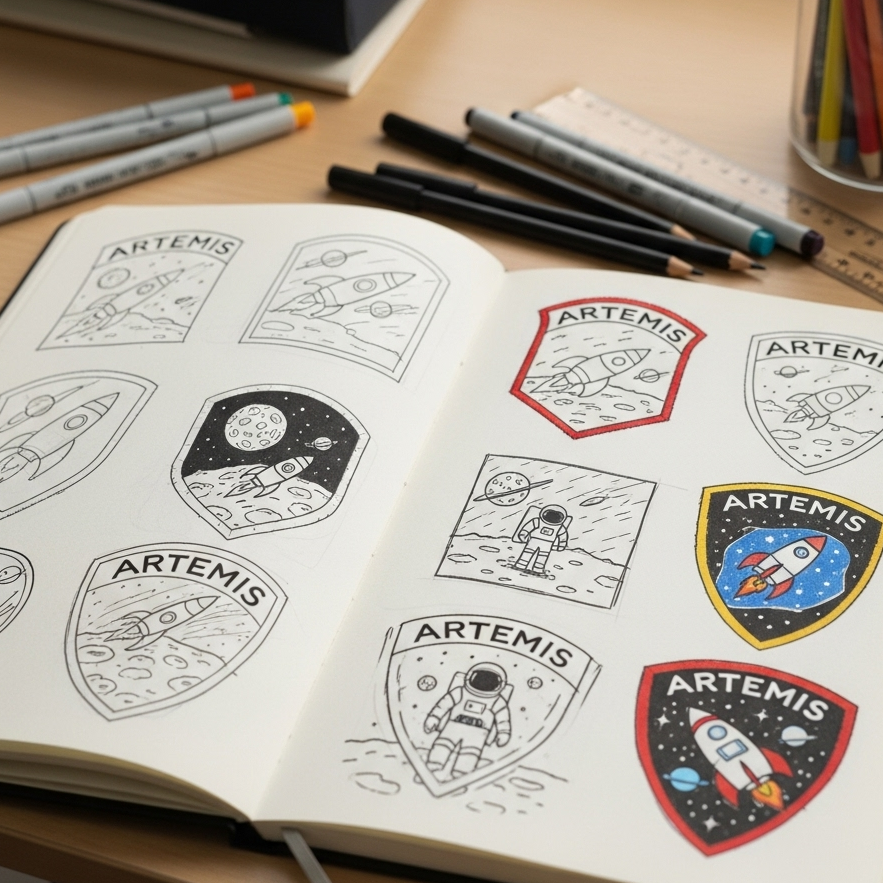Ready to make your mark on history? The NASA Next Moon Mission Patch Challenge for K-12 Students offers you a once-in-a-lifetime opportunity to design a piece of space exploration legacy. This isn’t just an art contest; it’s a chance to blend your creativity with the awe-inspiring science of America’s return to the Moon and journey to Mars. Whether you’re a budding artist, a future astronaut, or a science enthusiast, this guide will walk you through everything you need to know to create a stellar design and submit your entry with confidence.

Designing for Destiny: A Deep Dive into the Artemis Generation
The heart of any NASA mission patch is its story. Your design needs to do more than just look cool—it needs to communicate the goals, spirit, and vision of the mission it represents. For the foreseeable future, that mission is Artemis.
The Artemis program is NASA’s monumental endeavor to establish a sustainable human presence on the Moon, with an eye toward future missions to Mars. It’s about groundbreaking science, international collaboration, and inspiring the next generation of explorers—the Artemis Generation. That’s you!
Understanding the Core Themes of Artemis
To create a winning patch, you first need to understand the mission’s soul. According to NASA’s official Artemis overview, the key pillars you should consider weaving into your design are:
- Return to the Moon: The central theme is humanity’s return after more than 50 years. This includes the Orion spacecraft and the powerful Space Launch System (SLS) rocket that will carry astronauts there.
- The First Woman and First Person of Color on the Moon: Artemis is a mission of inclusivity. It will mark a historic milestone by landing the first woman and the first person of color on the lunar surface, a powerful symbol of progress for all humanity.
- Moon to Mars: The Moon is a stepping stone, not the final destination. The technologies and knowledge gained from living and working on the Moon will be crucial for the next giant leap: sending astronauts to Mars. Your patch could symbolize this forward-looking vision.
- International & Commercial Partnerships: Space exploration is a team sport. NASA is collaborating with international space agencies and commercial companies like SpaceX and Blue Origin. A successful patch often reflects this spirit of unity and shared goals.
- Science and Discovery: From searching for water ice at the lunar South Pole to studying the effects of the deep space environment, science is at the core of Artemis. Think about how you can represent the quest for new knowledge.

Elements of an Iconic Mission Patch
Every mission patch, from the historic Apollo badges to the emblems of the International Space Station, shares a common design language. In my experience advising students on STEM competitions, I’ve seen that the most successful applicants are those who masterfully blend these traditional elements with their unique artistic vision.
- Symbolism is Key: Don’t just draw a rocket; think about what it represents. A swoosh could symbolize speed and progress. A star could represent a fallen astronaut or a future destination. The number of stars might represent the mission number or the crew size.
- Shape Matters: Patches are often circular, but don’t be afraid to think outside the box if the rules allow. The shape of your patch can be symbolic in itself. An arrowhead shape, for instance, might represent pushing forward into the unknown.
- Color with Purpose: Colors evoke emotion and meaning.
- Red, White, and Blue: Often used to represent the American effort and patriotism.
- Gold and Silver: Can symbolize the excellence and achievement of the mission.
- Black or Deep Blue: Represents the vacuum of space.
- Include Essential Text: Most patches include the mission name (e.g., “Artemis III”) and the names of the astronauts on the crew. For a student challenge, you might include a theme name or your school’s name if permitted.
Navigating the Challenge: From Brainstorm to Submission
Once you’ve immersed yourself in the mission, it’s time to start the creative process. This is where your unique ideas will take flight.
Phase 1: Research and Brainstorming
- Study Past Winners: Look up the winners of previous NASA art contests and student patch challenges. The Artemis Moon Pod Essay Contest and other student challenges often showcase incredible creativity and provide insight into what resonates with judges.
- Sketch Everything: Don’t settle on your first idea. Fill a notebook with dozens of rough sketches. Combine elements, try different layouts, and play with shapes and symbols. This is the time for pure, unedited creativity.
- Get Feedback: Share your top 2-3 sketches with teachers, family, and friends. Ask them what story the patch tells them. Does it make them feel inspired? Is the message clear? This feedback is invaluable.

Phase 2: The Official Rules and Guidelines for your K-12 NASA Art Contest
This is the single most important step. Every year, NASA and its partners may slightly tweak the rules. It is absolutely crucial to read the official challenge announcement and guidelines meticulously. I’ve seen brilliant designs disqualified for simple, avoidable mistakes.
Look for specific details on:
- Eligibility: Is the contest open to your specific grade level (K-5, 6-8, 9-12)? Do you need to be a U.S. citizen?
- Design Constraints: Are there limitations on the number of colors you can use? What are the required dimensions and file formats (e.g., JPEG, PNG)?
- Required Elements: Does your design need to include the word “NASA” or a specific mission name? Are there any elements that are expressly forbidden (e.g., copyrighted characters)?
- Submission Deadline: Mark this on your calendar in big, bold letters! Deadlines for these challenges are absolute.
The official NASA STEM Engagement page is the best place to find this information once a challenge is announced.
You can often see announcements for these types of challenges on NASA’s official social media channels first.
Phase 3: Creating Your Final Design
Whether you’re using crayons, markers, or digital design software like Procreate or Adobe Illustrator, focus on creating a clean, bold, and vibrant final product.
- Clarity is King: Your design should be easy to understand, even from a distance. Complex, “busy” designs can lose their impact when scaled down to the size of a real patch.
- Digital vs. Hand-Drawn: Both methods are usually accepted. If you draw by hand, make sure you can scan or photograph your artwork in high resolution, with good, even lighting and no shadows.
- Write Your “Mission Briefing”: Many challenges require a short written explanation of your design. This is your chance to explain the symbolism and the story behind your patch. Write clearly and passionately. Connect each element of your design back to the mission’s goals.
Phase 4: The Submission Process
Follow the instructions on the official challenge website to the letter. This usually involves filling out an online form and uploading your digital artwork file and written description.
- Double-Check Everything: Before you hit “submit,” review your entry one last time. Is your name spelled correctly? Did you upload the right file?
- Keep a Copy: Save a high-quality copy of your design and your written statement for your own records and portfolio.
Being part of a NASA-related project is something to be proud of, no matter the outcome. Many student participants share their creative journey online.
You Are the Artemis Generation
Entering the NASA Next Moon Mission Patch Challenge for K-12 Students is about more than just winning a contest. It’s about being an active participant in one of the most exciting chapters of human exploration. It’s about taking the science, the engineering, and the ambition of the Artemis missions and translating it into a work of art that can inspire everyone who sees it.
Your design could one day be worn by astronauts or featured in a NASA broadcast. But even more importantly, the act of creating it connects you to the spirit of discovery that drives humanity forward. So, start sketching, start dreaming, and get ready to leave your legacy on our journey to the Moon, Mars, and beyond. Good luck!
FAQ
Q1: Do I need to be an amazing artist to enter the NASA patch challenge?
Absolutely not! While artistic skill is helpful, the judges are often more interested in the idea and the story behind your design. A simple but powerful concept that clearly communicates the mission’s goals can be more effective than a highly detailed but confusing drawing. Focus on creativity and symbolism.
Q2: Can I work with a friend or as a team?
This depends entirely on the official rules for that specific year’s challenge. Some NASA contests are for individuals only, while others may have categories for team or classroom submissions. Always check the guidelines carefully.
Q3: What happens if my design is chosen?
The prizes for winning a NASA challenge are often extraordinary and can vary. They might include having your patch officially produced, receiving a VIP tour of a NASA center, getting to speak with an astronaut, or receiving a scholarship. At the very least, you’ll get major bragging rights and a stunning piece for your portfolio.






